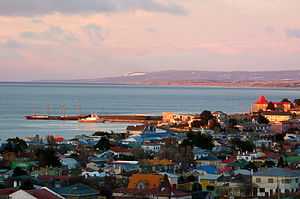County of Peebles (ship)
.jpg) | |
| Career (UK) | |
|---|---|
| Name: | County of Peebles |
| Owner: | R. & J. Craig, Glasgow |
| Route: | India—Great Britain |
| Builder: | Barclay Curle & Co., Glasgow[1] |
| Yard number: | 252[1] |
| Launched: | 5 July 1875[1] |
| In service: | 1875 |
| Out of service: | 1898 |
| Fate: | Sold to Chile, 1898[1] |
| Career (Chile) | |
| Name: | Muñoz Gamero |
| Acquired: | by purchase, 1898 |
| Fate: | Beached as a breakwater, 1960s |
| General characteristics [1] | |
| Type: | Windjammer |
| Tonnage: | 1,691 GRT 1,614 NT |
| Length: | 266 ft 6 in (81.23 m) |
| Beam: | 38 ft 7 in (11.76 m) |
| Depth: | 23 ft 4 in (7.11 m) |
| Sail plan: | Full-rigged ship |

The County of Peebles was the world's first four-masted, iron-hulled "full-rig ship", built in 1875 by Barclay Curle Shipbuilders in Glasgow, Scotland for the shipping firm R & J Craig of Glasgow.[3] Measuring 81.2m (266 feet 6 inches) long, with a beam of 11.8m (38 feet 7 inches), a draft of 7.1m (23 feet 4 inches) and displacing 1614 tons, she was a state-of-the-art windjammer when she entered the jute trade between Great Britain (e.g. Dundee and Cardiff), Bombay, India, and East India e.g. Calcutta / Hooghly River. Her rig was in the 'Scottish style' i.e. 'Royal sails above double top-sails and single topgallant-sails'. The County of Peebles represented an important development in sailing ship design, which allowed wind-powered ships to compete successfully on long haul routes with steam-powered ships in the last quarter of the 19th century.[4]
R & J Craig ordered a further eleven similar four-masted 'full-rigged ships' for the thriving Indian jute trade, forming what was referred to as the Scottish East India Line. Following the pattern set by the County of Peebles, the sister ships were also named after Scottish counties as follows: the County of Caithness (launched in 1876), the County of Inverness (1877), the County of Cromarty (1878), the County of Dumfries (1878), the County of Kinross (1878), the County of Selkirk (1878), the County of Aberdeen (1879), the County of Haddington (1879), the County of Edinburgh (1885), the County of Roxburgh (1886), and the County of Linlithgow (1887).
In 1898 the County of Peebles was sold to the Chilean Navy. Renamed the Muñoz Gamero, she was used as a coal hulk at Punta Arenas on the Strait of Magellan. In the mid-1960s she was beached as a breakwater in Punta Arenas, where she lies today with cut-down masts.[5]
References
- ↑ 1.0 1.1 1.2 1.3 1.4 "County of Peebles". Clydebuilt Ships Database. 2012. Retrieved 29 July 2012.
- ↑
- ↑ "Shipping news". Otago Witness (Dunedin, New Zealand). 2 February 2, 1878. p. 11. Check date values in:
|date=(help) - ↑ Cumming, Bill (2009). Gone....A Chronicle of the Seafarers & Fabulous Clipper Ships of R & J Craig of Glasgow. Glasgow: Brown, Son and Ferguson Ltd. ISBN 978-1-84927-013-7.
- ↑ "Punta Arenas, Google Maps". maps.google.com. 2012. Retrieved 29 July 2012.
External links
Coordinates: 53°10′37″S 70°55′03″W / 53.17698°S 70.91746°W